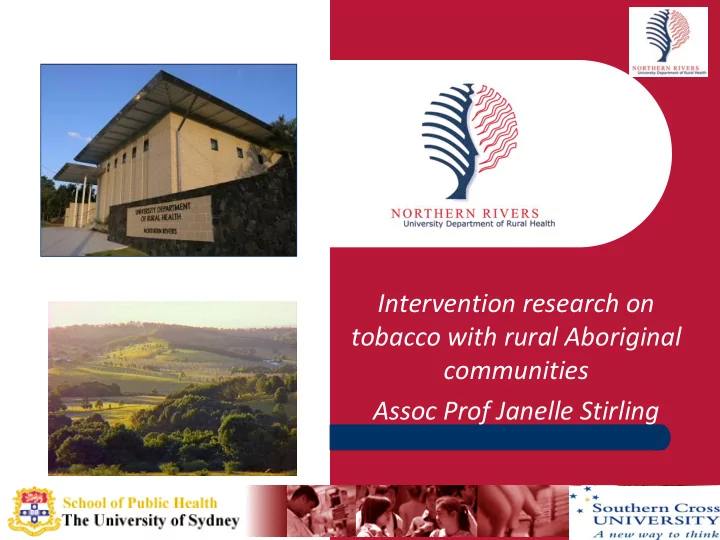

Intervention research on tobacco with rural Aboriginal communities Assoc Prof Janelle Stirling
History of Aboriginal Health Research 2003 Ivers (A & NZ Journal of Public Health) There was a major lack of research on and evaluation of tobacco interventions for Indigenous Australians 2006 Sanson-Fisher et al (MJA) The dominance of descriptive research in Indigenous health is not ideal, and our findings should be carefully considered by research organisations and researchers when developing research policies.
History of Aboriginal Health Research 2005/6 CRC Aboriginal Health (Annual Report) Facilitated Development Approach ....our research must be directed towards priorities identified by Aboriginal and Torres Strait Islander people and by those industry partners such as health services, which can make use of the research. 2010 Anderson (MJA) NHMRC Road Map II The third area of action...........intervention research to sustain health gains.... 2010 Stewart et al (MJA) A national intervention research agenda that encourages multidisciplinary research teams and community partnerships may offer a solution.
What do we know? Intervention studies are not easy to conduct in any setting however, the added complexities of doing so in Aboriginal health in a rural setting might explain why so few are conducted Descriptive research is required first to better understand the problem and identify barriers. Knowledge translation requires engagement of potential knowledge users as partners. (Canadian Institutes of Health Research)
Stop Smoking in its Tracks Research Team The project is guided by a local Community Dr Megan Passey Reference group (CRG) Prof Rob Sanson-Fisher A/P Janelle Stirling In collaboration with the local Aboriginal Ms Jennifer Gale Maternal & Infant Mrs Catherine Malla Health Strategy team Funding Source (AMIHS) DoHA
Qualitative Descriptive Study The NRUDRH was approached in 2007 by a local AMIHS team with concerns about the high rates of smoking in their client group. An initial qualitative descriptive study was conducted to explore reasons for smoking and the women’s perspective on what might help them quit. State-wide surveys on perceptions of smoking from service providers and pregnant women.
Intervention Study Develop intensive interventions using evidence base practice informed by qualitative study and survey data Study design to trial intervention: two control and two intervention sites All guided by the AMIHS team and local CRG
Engaging Sites and HREC approval University of Sydney GW & NC Area Health Services NSW Aboriginal Health and Medical Research Council Site visits involve (32 letters of support) travelling long distances
Project Governance Project steering committee DoHa (funding body) Area Health Services Site Specific Approval forms meetings with managers, AMIHS staff, senior executive briefings Local community reference group Site specific community reference groups
Building relationships Research team site visits include: • Community consultation • Meetings with managers • Meetings with AMIHS staff • Visiting local business to negotiate involvement with the project • Staff training • Monitoring project
Developing Interventions & Training staff Develop and implement AMIHS staff 2 day training program Develop interventions including 10 session fortnightly group activities program and other resources Clinical pathways flow chart Develop data collection tools Employ community based RA at sites All guided by the AMIHS team and local CRG
Risks Numbers small The trial will be conducted over 15 months with potential problems with staff turn over Project currently behind time due to lengthy process of getting HREC and AHS approval Need to keep consistency at both intervention sites which will not be easy as Aboriginal communities are diverse and AMIHS service delivery models differ
Where are we at now Staff training at intervention site 1 (local) completed Preliminary planning visit to intervention site 2 completed Training for intervention site 2 planned Training for control site 1 planned
Cyclical model New Research Funding Capacity in models services Descriptive research Time taken Project In community Governance engagement Intervention New knowledge research Small numbers in rural areas
Knowledge translation http://ktclearinghouse.ca/knowledgebase/knowledgetoaction 27 May 2010
Intervention research in Aboriginal rural health Complex, time consuming and risky Acknowledge the time and cost of community consultation especially in rural areas Need for job security and support structures for Indigenous researchers in rural settings Building capacity in health services to engage with the research process More emphasis on getting research into policy and practice Streamline processes
Recommend
More recommend